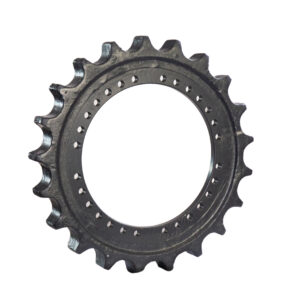The positioning of the excavator sprocket plays a crucial role in distributing weight across a tracked vehicle, impacting its balance and overall stability. The sprocket, located at the rear of the undercarriage, serves as the drive mechanism for the tracks.
Here’s how its positioning affects weight distribution:
- Weight Distribution: The sprocket’s position influences the distribution of the vehicle’s weight between the front and rear sections. As the drive component for the tracks, the sprocket applies force to move the tracks, which, in turn, propels the vehicle. Its placement affects how the vehicle’s weight is distributed along the tracks.
- Traction and Ground Contact: Proper positioning of the sprocket ensures adequate tension in the tracks, maintaining sufficient contact between the track shoes and the ground. This maximizes traction, preventing slippage, and ensuring efficient power transfer to the tracks.
- Balanced Weight Transfer: The positioning of the sprocket aids in balanced weight transfer during operation. It helps distribute the machine’s weight evenly across the undercarriage, minimizing excessive stress on specific components and ensuring stability during various maneuvers and loading activities.
- Counterbalance: Together with other undercarriage components like the idler and track rollers, the sprocket contributes to counterbalancing the weight of the upper structure of the excavator. This counterbalance enhances stability, preventing tipping or loss of control during operation.
- Impact on Maneuverability: Properly positioned sprockets allow for smooth and precise maneuverability. excavator sprocket They ensure that the excavator can turn efficiently, maintaining stability without skidding or excessive strain on the tracks.
- Load Distribution: In scenarios where the excavator is engaged in heavy lifting or loading activities, the positioning of the sprocket helps evenly distribute the additional load across the tracks and undercarriage, preventing excessive stress on any single point.
In essence, the strategic positioning of the sprocket on the tracked vehicle’s undercarriage plays a critical role in ensuring proper weight distribution, balanced traction, stable maneuverability, and efficient power transmission. This positioning optimizes the excavator’s performance and stability across a range of operating conditions and tasks.
Can excavator sprocket be customized based on the specific requirements of heavy machinery?
Yes, excavator sprockets can be customized based on the specific requirements of heavy machinery. Customization allows for the adaptation of sprocket designs to meet particular operational needs, working conditions, or equipment configurations. Here’s how customization can occur:
- Material Selection: Depending on the application and working environment, different materials or alloys can be chosen for sprocket construction. This customization considers factors like wear resistance, strength, and durability required for specific conditions.
- Design Modifications: Sprocket designs can be tailored to accommodate different track configurations, widths, or pitch lengths. Custom designs may involve adjusting tooth profiles, pitch diameters, or the number of teeth to suit the specific requirements of the machinery.
- Heat Treatment and Hardening: Customization may involve specific heat treatment processes to enhance the sprocket’s hardness, durability, and resistance to wear. Heat treatment methods like induction hardening or carburizing can be customized based on operational demands.
- Size and Geometry: Customizing the size and geometry of the sprocket can optimize its performance for particular applications. This includes adapting dimensions, hub configurations, or flange sizes to ensure compatibility and efficient power transmission.
- Specialized Coatings or Surface Treatments: Custom coatings or surface treatments can be applied to sprockets to improve corrosion resistance, reduce friction, or enhance wear characteristics based on the operating environment.
- Load and Stress Analysis: Customization may involve conducting load and stress analysis to determine the optimal sprocket design for heavy machinery operating under specific loads, speeds, or working conditions.
- Compatibility and Interchangeability: Customized sprockets can be engineered to ensure compatibility with existing undercarriage components and interchangeability with standard parts, facilitating easier maintenance and replacements.
- Environmental Considerations: Customization can address environmental factors such as extreme temperatures, abrasive terrains, or corrosive conditions by selecting materials and designs tailored to withstand these challenges.
Customized excavator sprockets are often designed in collaboration with manufacturers or specialized engineering firms to meet the precise needs of heavy machinery in diverse industries such as construction, mining, forestry, and agriculture. This customization ensures optimal performance, increased durability, and reduced downtime for the equipment.

Comments